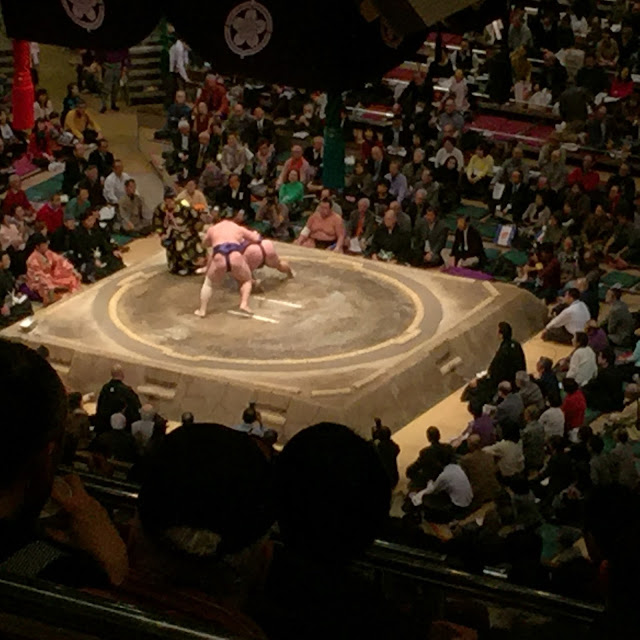After the
unexpected snowfall on Monday, we were back to a sunny—albeit windy and
cold—day for sumo. I was excited. I’ve
always been fascinated by it, but after watching several bouts on TV I’ve
become a huge sumo fan and couldn’t wait to experience the whole only-in-Japan
event.
Tickets are
available as either box seats or western seats (chairs) in various amounts of
money. Box seats were out of the question for many reasons—the main one being
that they consist of only cushions on the floor within a very tiny piece of
real estate. Our Japanese friends told us these areas are mostly for the older,
traditional (and tiny) Japanese fans. Regardless, I knew there was no way I
could sit on a pillow for longer than ten minutes so we went for the cheapest
reserved seats (about $45pp). There are cheaper $25 seats available for previously
unsold seats if one wants to arrive on the day of the event around 8am, and
hope something is available—but I wasn’t taking any chances of missing out, so we
opted for the reserved options. Here’s the official link to purchase tickets: http://sumo.pia.jp/en/.
With a pre-purchased
ticket one has the option of going to the sumo hall anytime after 8am when the
doors open with the bouts starting at 8:30am. However, few people come that early
since it’s only junior wrestlers in the early part of the day. The top division
of wrestlers doesn’t start until 3:45, and the division directly under them—the
Juryo—doesn’t start until 2:20pm. We got there about this time and the stadium
was still pretty empty.
I didn’t
care that we were early, in sumo-viewing terms, however. I wanted to explore
the stadium and the sumo museum, and take advantage of any and all the available
photo ops (of which there were blissfully quite a few), and to fully absorb the
whole experience.
And there
were lots of fun surprises starting at the subway station of Ryogoku
Kokugikan. Here there were huge paintings of some of the top wrestlers, a
display featuring their handprints and autographs, and lots of posters for the tournament.
It was obvious we were in the right place and about to see sumo.
Exiting the station, there were a few tables selling sumo
trinkets, and a small stone statue of two wrestlers.
In this area between the station and the stadium there are
more vendors for gifts and food. We stopped to have a nibble of fried chicken
pieces and hot sake before heading to the stadium. Near here is also the South
Gate where all but the highest-ranked wrestlers enter the stadium which makes
it a great chance for photos of the rising stars.
After picking up our tickets at will-call, we went on
through the gates and directly found some fun photo opportunities.
Then we entered the stadium, and on the right, just past the huge cardboard cutouts of the sumo champions (more photo ops), is the small sumo museum which is currently featuring the life of a champion who recently died. Facing this main entrance is a huge display case of past trophies, and going left we found food and gift stalls.
Finally we entered the hall itself and I was surprised at
how empty it still was, but by later in the afternoon when the higher division
wrestlers began, the place was filled.
Though there is an option to rent a radio that announces
everything in English, I actually enjoyed the fact I couldn’t understand what
was being said and was able to just listen to the cadence of the announcer’s
words. When the sponsor’s flags were marched around the ring I didn’t know that
he was probably saying something along the lines of ‘This is brought to you by
the dried soup sponsor…’ I got to hear it as melodic sounds and it was much
more aesthetically pleasing.
The afternoon was filled with ancient history and modern-day
sponsor flags. It was beyond interesting and so much fun watching and listening
to everything: the announcements of the wrestlers names as they all entered at
once, climbed up into the ring, circled it, then raised their arms and their
ceremonial aprons; the wrestlers getting ready to fight; the men who came out
before each bout to sing its announcement; the referee’s calls; the Shinto dances
of the top champions; the excitement of the quick bouts; and the crowd calling
out the names of their favorite superstar. Some of the wrestlers took longer to
get ready to fight then the bout lasted. They would puff up their chests, and
stomp and slap themselves, then throw out handfuls of salt to purify the ring,
and the crowds would cheer their bravado. Sometimes they would do it multiple
times, then face off, and a few minutes later one—sometimes both—would be on
the ground and one declared a winner.
It was awesome and I’d go again in a minute. And that’s
saying a lot from one who doesn’t much like sports.


























